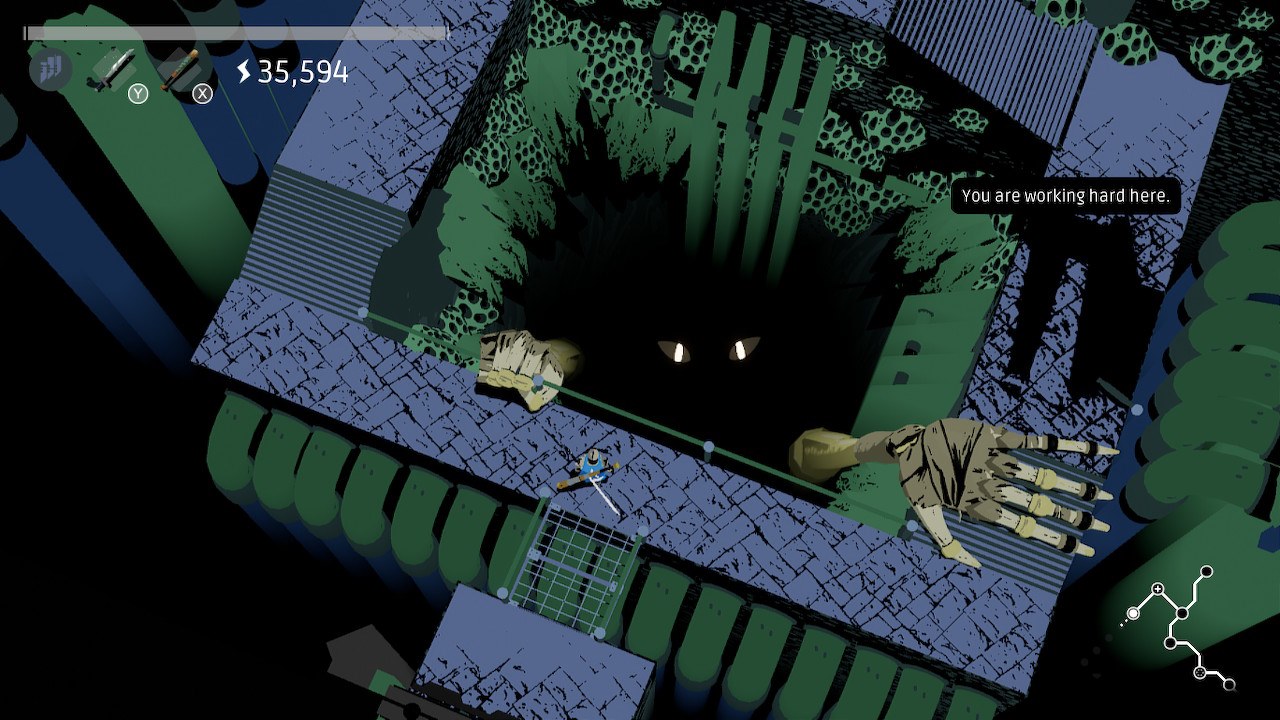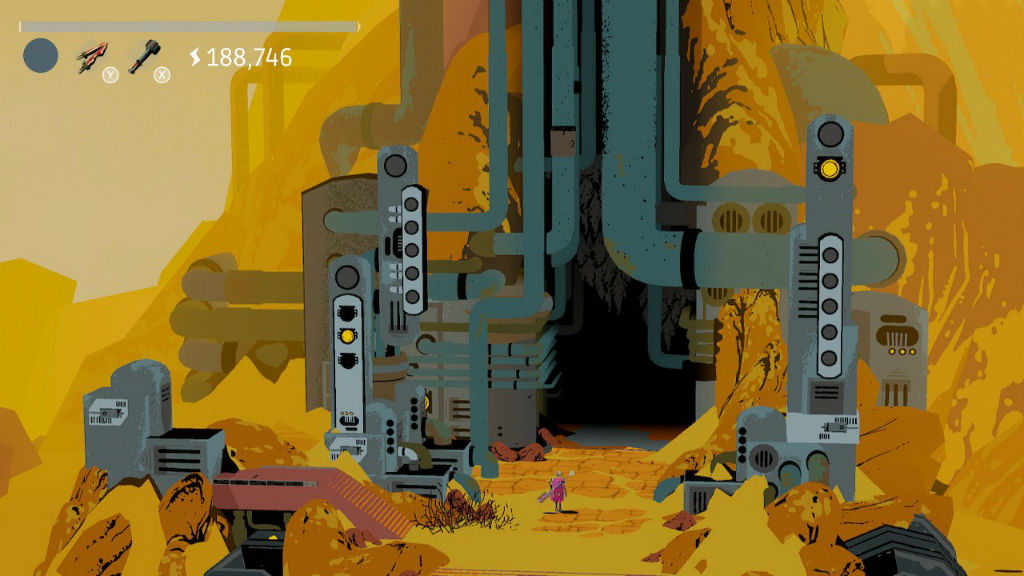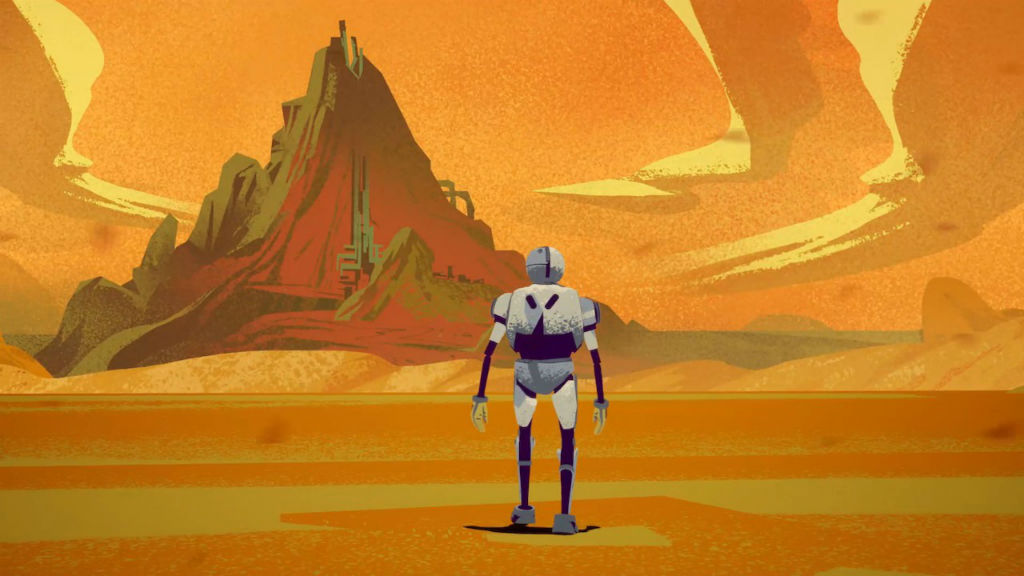The titular Creature In The Well‘s eyes are always watching you work, but as you play, you learn that it also likes to talk. Before you reach the end of a level, it will taunt you and talk about all the ways it will make sure you fail. And when you do, its arms pick you up and throw you to the outside of the well it peeks out of, ready to taunt you once more.
You’ll later read that it’s spoken to hundreds of now-destroyed robots that kept the Machine In The Mountain working before it stopped altogether. And one of the most interesting things it says is a question: Why after all these years did you, a single robot, peek your head out of the sand and make your way back to the mountain to singlehandedly turn the machine back on?
It’s actually, well, a really good question. And as the game goes on and the frustrations mount, you’ll wonder a lot more about the why than anything else about what’s a beautiful and oftentimes exciting title from Flight School. The company describes Creature In The Well as pinball with swords, but it starts as pinball with a stick and frying pan. One tool charges the energy orbs up, the other strikes it to move said ball in a certain direction. You work your way up from there with new tools and, as a result, abilities.
It is, essentially, pinball in a dungeon crawler. Each level ends in a boss battle as certain portions of the machine are reactivated and the story unfolds. There’s a lot to like about the game at first blush. It’s a visually satisfying puzzle game that’s often far more dungeon crawler than shooter. The combination works: It’s refreshing that a game that often feels so chaotic rewards precision and timing in certain circumstances. The puzzles are unique and the visuals are stunning, with each level getting its own unique color palate and features. But as the levels go on, the chromatic satisfaction wears off and the basic set pieces all look the same, because they are.
It’s tough to criticize because it should be the same. It all takes part in the same factory, after all. Some of the features and set pieces build upon themselves over time, with new bumpers and electrical gizmos to make things a bit more complicated. But as the game gets harder, the frustrations with the mechanics themselves grow and not everything is nearly as intuitive as the minimalist design should be.

For a game so beautifully stylized, it’s surprisingly unintuitive in a number of ways. Controller vibrations, for example, are both good and bad. For the longest time I couldn’t tell if energy orbs were hurting my robot or not — until enemy-fired orbs absolutely were hurting my robot. And many players were unaware that the white pools were actually good for you because they recharge your health bar, despite the deceptive vibrations from your controller. They’re little things, but it’s enough to make you wonder exactly what’s going on pretty much all the time, especially as the puzzles get harder and the game gets more frustrating.
The level map itself also has a learning curve as it twists and turns, and the way forward to progress in the game is murky as well. Once you get through the game’s first two levels, there are multiple machine parts to tackle, with no clear indication which one is easier than the other. It’s also not clear that the secret paths are not optional. Without the orbs and items in there, the game is basically impossible to beat.
The truth is you basically have to play parts of each to find the upgraded tools you need, then circle back to the parts you got frustrated with in order to clear them. Unless you’re a dungeon pinball pro, that makes for a lot of backtracking and feeling silly about trying to beat a difficult room with your current arsenal that a single tool could easily crush. It never felt like I was getting the hang of it all, just stumbling into the solutions that had little to do with me for reasons I never quite understood.

Creature In The Well was a game I very badly wanted to get better at, but could never quite figure out how I was failing and how to improve. Advancing felt more about stumbling into the tool needed to complete the task, not actually utilizing said tools to improve my skills. And when the beautiful graphics got repetitive and I was left with a small group of rooms and bosses I was struggling to get past, it was a lot easier to focus on the game’s flaws.
It felt far too easy, for example, to get the electricity you need to open doors, making collecting it — the entire point of many rooms — not feel worthwhile at all. By the game’s end, I had a million bolts worth of the current I would never need. If I were actually bad at this, and not just feeling bad at this, why is does this task never feel like a challenge after basically the game’s first level?
I wanted to love Creature In The Well for a lot of reasons, but mostly because it’s visually striking and minimalist, and the mechanics are unique. There were stretches where I was in the zone, so to speak, and cruising through the story and felt like I was getting the hang of things. When those times faded, though, the voice of the creature’s doubt kept creeping back in. Why did I think I was good enough to overcome all this if I’m just some ordinary robot at the controls?







